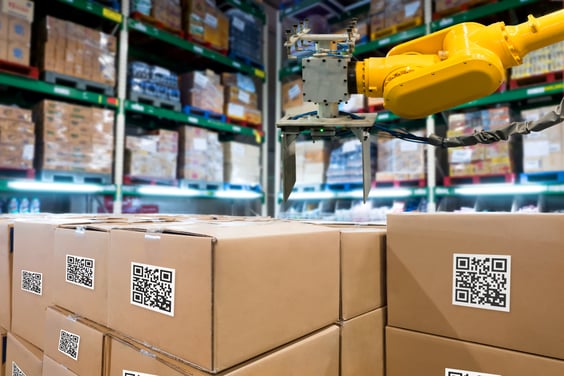The globalized world relies on intricate supply chains, weaving together a complex tapestry of production, transportation, and distribution. While offering undeniable benefits, this interconnectedness exposes us to vulnerabilities.
Disruptions – from natural disasters to pandemics – can ripple through entire chains, causing economic hardships and impacting people and the environment alike. Building resilient supply chains that withstand such challenges is no longer an option; it’s a necessity. But resilience goes beyond mere survival; it requires incorporating environmental health and safety (EHS) considerations to build a sustainable and secure future.
The Ripple Effect of Disruption on EHS
Supply chain disruptions can trigger a cascading series of negative consequences for environmental health and safety, impacting various stakeholders and ecosystems. Here’s a closer look at the potential ripple effects across different areas.
Environmental Damage
- Improper Waste Disposal: Disruptions can lead to overwhelmed waste management systems, illegal dumping, and increased landfilling, polluting soil and water resources.
- Increased Emissions: Disrupted logistics, such as rerouting shipments or using less efficient modes of transport, can lead to higher greenhouse gas emissions and air pollution.
- Hazardous Material Releases: Accidents during disruptions, abandoned facilities, or improper storage can result in spills or leaks of hazardous materials, contaminating air, water, and soil.
- Biodiversity Loss: Unsustainable sourcing practices adopted during disruptions can contribute to deforestation, habitat destruction, and loss of biodiversity.
Worker Safety Risks
- Unsafe Working Conditions: Natural disasters, pandemics, or political instability can create unsafe working conditions, such as damaged infrastructure, exposure to hazardous materials, or lack of access to safety equipment.
- Limited Access to PPE: Shortages of personal protective equipment (PPE) due to disruptions can leave workers vulnerable to exposure to harmful substances or unsafe tasks.
- Increased Stress and Mental Health Concerns: Disruptions can lead to job insecurity, economic hardship, and increased stress for workers, impacting their mental well-being and potentially leading to safety risks.
- Exploitation and Unethical Practices: During disruptions, pressure to maintain production can lead to increased working hours, unfair labor practices, and exploitation of vulnerable workers.
Community Impacts
- Access to Essential Goods: Disruptions can lead to shortages of essential goods like food, medicine, and clean water, creating hardship and jeopardizing public health within communities.
- Economic hardship: Businesses reliant on disrupted supply chains may face closures or layoffs, impacting local economies and livelihoods.
- Infrastructure Damage: Natural disasters or other disruptions can damage essential infrastructure like transportation networks, water treatment facilities, and healthcare systems, further impacting communities’ well-being.
- Social Unrest: Shortages of essential goods and economic hardship can lead to social unrest and instability within communities.
Ethical Sourcing Concerns
- Pressure to Cut Corners: During disruptions, organizations may be tempted to source from suppliers with lower EHS standards to maintain production, compromising worker rights and environmental responsibility.
- Lack of Transparency: Disruptions can make it harder to track sourcing practices and ensure ethical treatment of workers and responsible environmental management throughout the supply chain.
- Increased Risk of Human Rights Abuses: In unstable regions or under pressure to meet production demands, unethical labor practices like child labor or forced labor may become more prevalent.
- Reduced Consumer Confidence: Unethical sourcing practices exposed during disruptions can damage brand reputation and consumer trust.
By understanding these potential ripple effects, organizations can develop more comprehensive EHS risk management strategies for their supply chains. Remember, building resilience goes beyond simply weathering disruptions; it’s about proactively mitigating risks, prioritizing ethical practices, and ensuring the well-being of both people and the environment throughout the entire value chain.
Building EHS-Driven Supply Chain Resilience
The globalized nature of today’s supply chains exposes us to various vulnerabilities, making resilience a crucial factor for sustainable success. Integrating environmental health and safety considerations into your supply chain practices empowers you to navigate disruptions while minimizing adverse impacts and ensuring long-term viability. Here’s a deeper dive into key strategies for building EHS-driven resilience:
EHS Integration
Embed EHS throughout the chain. Integrate EHS considerations into every stage, from supplier selection and risk assessments to auditing and continuous improvement programs. Consider factors like:
- Supplier’s safety management software: Evaluate their commitment to safety, environmental responsibility, and worker well-being.
- Environmental impact: Assess potential emissions, waste generation, and resource usage throughout their operations.
- Worker safety practices: Evaluate accident rates, safety protocols, and access to PPE for their workforce.
- Develop EHS policies and procedures: Establish clear guidelines and expectations for EHS practices throughout your supply chain. Communicate these expectations effectively to all stakeholders.
- Train and empower employees: Equip your team with the knowledge and skills to identify and address EHS risks within the supply chain.

Sustainable Sourcing
- Partner with responsible suppliers: Prioritize suppliers committed to ethical sourcing practices, environmental responsibility, and robust EHS management systems. Look for certifications like Fair Trade or B Corp.
- Traceability and transparency: Implement supply chain mapping and monitoring tools to ensure transparency and traceability of materials and processes throughout the chain.
- Collaborate with NGOs and industry groups: Partner with organizations promoting responsible sourcing practices and sustainable supply chain initiatives.
Diversity & Redundancy
- Diversify your supplier base: Avoid overreliance on single sources to minimize vulnerability to disruptions in specific regions or sectors.
- Build redundancy into critical areas: Identify critical components or materials and establish alternative suppliers or production locations to mitigate single points of failure.
- Invest in local sourcing: Consider sourcing materials and goods closer to your production facilities to reduce reliance on long-distance transportation and its associated risks.
Risk Management
- Proactive risk assessment: Regularly assess potential EHS risks throughout your supply chain, considering natural disasters, political instability, pandemics, and other potential disruptions.
- Develop mitigation plans: Create comprehensive plans to address identified risks, including emergency response procedures, communication protocols, and alternative sourcing strategies.
- Conduct regular audits and reviews: Continuously monitor and evaluate your EHS risk management strategies and make adjustments as needed.
Digitalization and Transparency
- Leverage technology: Utilize data analytics and digital tools for real-time visibility into your supply chain, enabling proactive risk identification and management.
- Implement traceability solutions: Employ tools to track materials and products throughout the chain, ensuring transparency and ethical sourcing practices.
- Communicate openly and transparently: Share relevant EHS information with stakeholders, including suppliers, customers, and communities, fostering trust and collaboration.

Collaboration and Partnerships
- Collaborate with suppliers: Work with suppliers to implement joint EHS initiatives, share best practices, and address shared challenges.
- Engage with industry peers: Share knowledge and resources with other organizations in your industry to build collective resilience and advocate for responsible supply chain practices.
- Partner with government agencies: Work with government agencies involved in regulating EHS standards and sustainability initiatives to contribute to broader systemic improvements.
Remember, building EHS-driven supply chain resilience is an ongoing process. By continuously assessing risks, adapting strategies, and prioritizing sustainability throughout the chain, organizations can navigate disruptions effectively, contribute to a healthier planet, and ensure long-term success in a dynamic global landscape.
Investing in a Sustainable Future
Embracing EHS-driven practices within your supply chain isn’t just about mitigating risks and ensuring compliance; it’s about proactively contributing to a sustainable future where economic prosperity goes hand-in-hand with environmental well-being and social responsibility. Here’s a deeper dive into the benefits of investing in this holistic approach:
Environmental Impact Reduction
- Minimize waste and optimize resource use: By implementing sustainable practices throughout the supply chain, organizations can significantly reduce waste generation, conserve natural resources, and minimize their environmental footprint. This can involve adopting circular economy principles, utilizing recycled materials, and employing energy-efficient technologies.
- Lower greenhouse gas emissions: Optimizing logistics, investing in renewable energy sources, and implementing sustainable transportation solutions can dramatically reduce greenhouse gas emissions associated with the supply chain. This contributes to combating climate change and mitigating its environmental and social consequences.
- Promote biodiversity and ecosystem health: Responsible sourcing practices and sustainable resource management can help protect biodiversity, conserve valuable ecosystems, and combat deforestation. This ensures the long-term viability of resources and protects natural habitats for future generations.
Worker Well-being and Social Responsibility
- Ensure safe working conditions: By prioritizing EHS throughout the supply chain, organizations can contribute to safer working conditions for all workers involved. This involves implementing robust safety protocols, providing proper training and personal protective equipment, and fostering a culture of safety-first within all supplier operations.
- Promote fair labor practices: Ethical sourcing practices ensure fair wages, decent working hours, and respect for human rights throughout the supply chain. This combats exploitative practices like child labor or forced labor, contributing to a more just and equitable global community.
- Empower communities: Sustainable supply chains can promote economic development and empower communities by creating fair employment opportunities, investing in local infrastructure, and supporting sustainable livelihoods. This fosters stronger community resilience and contributes to overall social well-being.
Enhanced Brand Reputation and Long-Term Profitability
- Consumer trust and loyalty: Consumers increasingly expect businesses to operate responsibly and prioritize sustainability. By demonstrating a commitment to EHS in their supply chain, organizations can build consumer trust, loyalty, and brand reputation.
- Reduced operational risks and costs: Proactive risk management and EHS compliance can minimize disruptions, legal liabilities, and associated costs. Additionally, investing in sustainable practices can lead to long-term cost savings through resource efficiency and improved operational efficiency.
- Attract responsible investors: Investors are increasingly focusing on environmental, social, and governance (ESG) factors when making investment decisions. Organizations demonstrating strong EHS practices in their supply chains can attract responsible investors and secure long-term financial stability.
The Road Ahead
Investing in a sustainable future through EHS-driven supply chains requires a long-term commitment and continuous improvement. It’s not just about short-term gains; it’s about building a resilient, responsible, and prosperous future for generations to come. By taking a proactive approach and prioritizing EHS throughout the chain, organizations can play a crucial role in shaping a world where economic success, environmental responsibility, and social well-being coexist in harmony.



